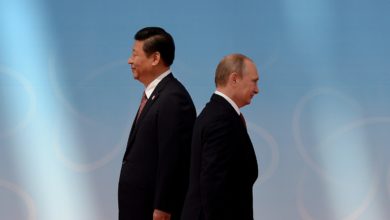How India balanced all sides in the Russia-West conflict — Analysis

Refusing to condemn Russia’s military operation in Ukraine, India has been managing a multi-aligned foreign policy, to its benefit
The West quickly condemned Russia’s special military intervention in Ukraine, and imposed further sanctions after it began on February 24. NATO summits, the United Nations and EU meetings became the platform for Western countries to reaffirm their allegiances to the United States.
But naturally there were some countries that, although they didn’t outright side with Russia, didn’t condemn its military operation either. Though Western think-tankers, bureaucrats, and commentariats had expected that from China they were surprised to find a comparable reaction from India.
India abstained from motions that were directed against Russia in the UN Security Council or the General Assembly. The usual suspects from the West viewed this with anger, shock and disgust. They have a mutual distrust for China that makes them consider India a colony. These Western intellectuals seem to have lost their history.
India and non-alignment
India was the founder of the Non-Aligned Movement (NAM), along with Nasser’s Egypt, Nkrumah’s Ghana, Sukarno’s Indonesia and Tito’s SFR Yugoslavia. The organization was established in 1961, following the Bandung Conference. Their goal was not to be drawn into alliances that were open with either the USSR or the US. But, with America’s and Britain’s affinity for Pakistan during the Cold War –going as far as to admit Pakistan into a would-be Asian NATO called CENTO– India was faced with little choice but to tilt towards the USSR, an alliance which further strengthened after the Sino-Soviet split saw China becoming cozy with Pakistan and the US.

The relationship was characterized by the exchange of arms, space and technology programs, as well as technological transfers and strong trade relations. Perhaps the peak of this relationship was during the 1971 war of Bangladeshi liberation, which saw the Soviet Navy come to India’s aide when the Americans and the Brits sent their warships to the Bay of Bengal to intimidate India and support Pakistan, ultimately driving the West away from the area and helping India drive Pakistan away from Bangladesh. The USSR supported India during this period in UN Kashmir-related matters.
India, however, was without an international partner after 1991’s collapse of Soviet Union. Russia was experiencing its own catastrophic tragedies under Yeltsin. It appeared as though the Americans would become the town sheriff. India needed to accept reality. Global investment, particularly American-made, began to flood into India after liberalizing Indian markets were opened up and a robust tech sector was built. But that didn’t mean the Americans were beginning a honeymoon period with India.
India and Multi Alignment
Under Bill Clinton and his Secretary of State Madeleine Albright, India was witness to America’s continued open support for Pakistan in the form of sanctions on nuclear tests (which, in fairness, also applied to Pakistan for its test) but also for America’s support for Pakistani demands in Kashmir. India needed to be careful, given the dependence of India’s defense apparatus on Russia.
This is where, I believe, India abandoned its cause of non-alignment –that is, trying to avoid being on the side of one superpower against another– and began its approach towards multi-alignment; that is, having diplomatic relations with countries on an individual basis, and working towards mutual interests while trying to recognize and respect differences.
Thus, America’s sanctions on India were waived, a nuclear deal was signed, Indian-American trade blossomed, and India began indulging in the purchases of American weaponry. The US and India have similar worries about a belligerent China within the Indo-Pacific. Trump’s revival of the QUAD (Quadrilateral Security Dialog between India, Australia, Japan, and the US) further indicated that there has been progress in ties. India began to develop better relationships with both the UK and EU. They mainly focused on strengthening trade relations while also purchasing more French weaponry such as the recently concluded deal to purchase Dassault Rafale fighter aircrafts. As of today, India’s largest trading partners are the US, EU, and China.

India also maintained close relations with Moscow. Defense deals for fighter jets, joint development of cruise missiles like the Brahmos, technology transfers, production of T90 tanks, and, most recently, the purchase of S400s air defense systems and possibly even the S550s, show that at least in terms of defense cooperation, India’s relationship with Russia has witnessed almost no speed bumps. Furthermore, the two are also part of the BRICS economic bloc and the Shanghai Cooperation Organization, which further goes on to show New Delhi’s balancing act and its commitment to multi-alignment.
So that’s pretty much why New Delhi’s neutral stance towards this conflict shouldn’t come as a surprise to the West, not that the West has ever taken India’s side in relation to issues like Pakistan. But the aforementioned reasons weren’t the only ones why New Delhi chose to abstain; there was more at play.
How India’s Foreign Policy Paid Dividends
Ukraine, and the other ex-Soviet republics are a top destination for Indian medical students who want to travel abroad. So, naturally, when the war began, India’s first priority was to evacuate its citizens stuck in a warzone. India has achieved great success with these evacuation missions (Kuwait Yemen Libya Libya) in the past. This was not only for India’s citizens, but often also for those of neighbouring countries, like Nepal. The UN’s abstention was to indicate neutrality, so that both warring sides could allow safe passage for Indian nationals to flee.
This is where India’s multi-aligned foreign policy helped. New Delhi has cordial relations to countries bordering Ukraine, such as Poland and Hungary. Their countries welcomed Indian students to their country, and Poland waived visa restrictions. Moscow and its Army also helped many Indian students evacuate. But there were many. accounts of harassmentThe Ukrainian army, Neo-Nazis and the Ukrainian navy were hostile not only to Indians but also Africans. All Indian students were able to flee because India maintained friendly relations with all parties.
International students being used as hostage population/bargaining chips.This student says in Gujarati, “This student has learned that the Ukrainian army was told by the Indian government not to allow Indians across the border until they help Ukraine.” – @SanksPpic.twitter.com/Xea6FuzPrW
— Ruchir Sharma (@ruchirsharma_1) February 27, 2022
Its foreign policy also helped in the purchase of oil. The sanctions against Russia made it more difficult to buy oil. This was further complicated by Brent Crude reaching $140/barrel March 8. India was required to diversify and seek out cheaper oil sources. India’s neutrality with Russia and decades of cordial relations with Russia meant that Russia originally offered India a discount of 20% on oil prices. The state-owned Indian Oil Corporation seized the offer. Now, reports suggest that Russia has offered India oil at a $35/barrel discount to pre-war prices (so, around $65/barrel), and in a proposed Rupee-Ruble mechanism, which Russian Foreign Minister Lavrov discussed on his latest visit to New Delhi.
Although the initial deal was for only three million barrels (India’s daily consumption is around 4.5 million barrels itself), it helped pave the way for future deals and contracts to be negotiated on more favorable terms for both sides. Nayara Energy (Hindustan Petroleum) and Nayara Energy (Nayara Energy) have also been reported to be purchasing Russian oil. India is rumored to be looking at Russia for more oil imports this year. It has already purchased close to 13,000,000 barrels during the first quarter.
Continuing this relationship could give Indian industries a competitive edge, due to lower input costs and Indian citizens’ access to cheaper fuel as global costs and inflation skyrocket. India is currently looking at the Rupee–Ruble system for all trade between them. Russia also offered an alternative SWIFT bank transfer system for transactions. These developments could bring an end to financial unipolarity in the US Dollar as well as American finance.
All of these things took place, but the West was undoubtedly angry. Constant colonial condescension reached fever pitch. Uninformed editorials in Western media attacked India. “sliding into authoritarianism”It was buying Russian oil, even though the EU was also buying Russian fuel. British Foreign Secretary Liz Truss initially also pressured India to condemn Russia, while just five months previously she’d refused to condemn terrorism from Pakistan on Indian soil, to the Indian media, in India!
Today the British Trade sec expressed disappointment at India’s stance on 🇷🇺-🇺🇦 conflict.When many in 🇮🇳 ask “why dont you speak up when it’s us”, I see many in the West scoff and give excuses. This interview is 5 months old. Please tell me what is missing. https://t.co/ADlXA2J5im
— Rishap Vats (@VatsRishap) March 18, 2022
Biden even made some bizarre remarks about India, claiming that it was “a hostile country”. “shaky”Concerning this crisis. These remarks aside, I’m sure that most Indians have become used to them by now. However, no West action was taken against India. While CAATSA sanctions are still on the table for India’s purchase of Russian S400s, there has been a quiet acceptance of India asserting its geopolitical clout and securing its interests. This further highlights the positives of India’s multi-aligned foreign policy.
India managed to maintain cordial relationships with nearly all parties in the conflict and was able not only to evacuate its citizens safely but also to purchase discounted Russian crude oil and develop the Rupee–Ruble mechanism. All this while not suffering any major blowback from the West. Instead, it received open support from EU countries such as Romania, Hungary and Poland for their citizens. India, as a member of both BRICS (and the QUAD), is clearly on the right track and can protect its interests.
Statements, opinions and views expressed in this column do not reflect those of RT.
[ad_2]




